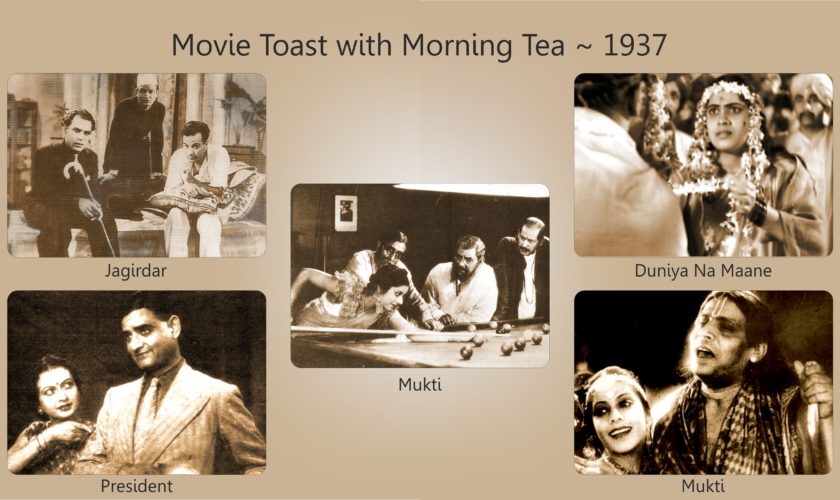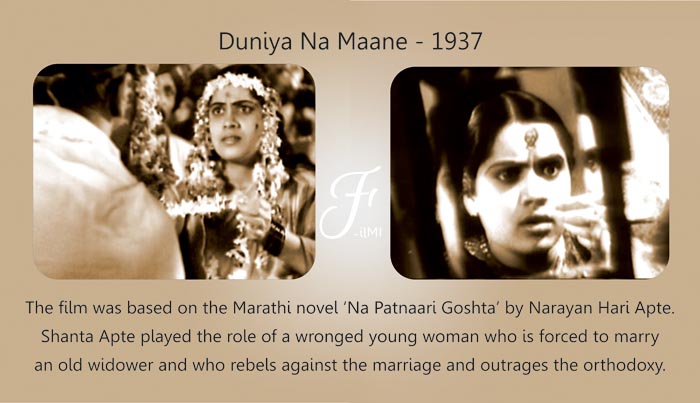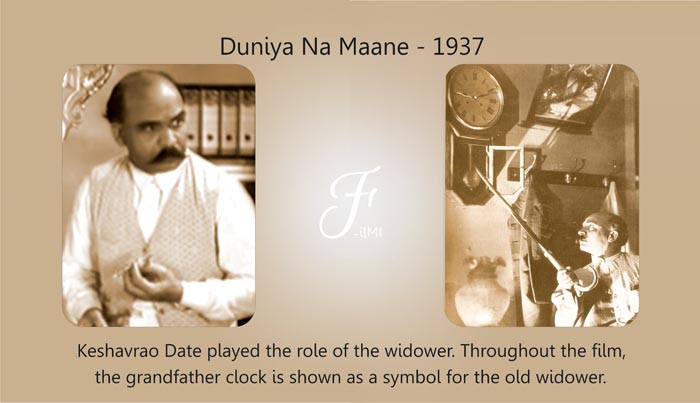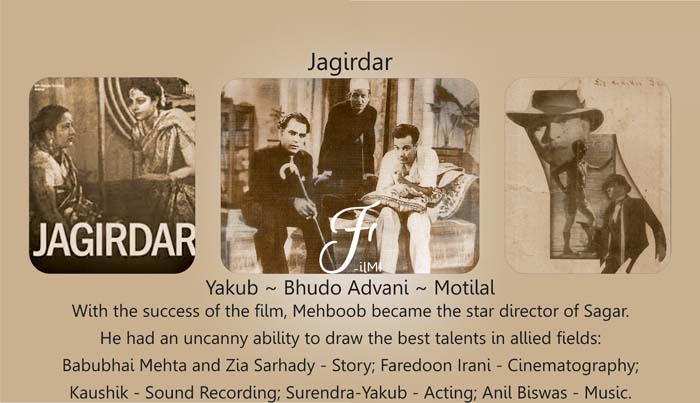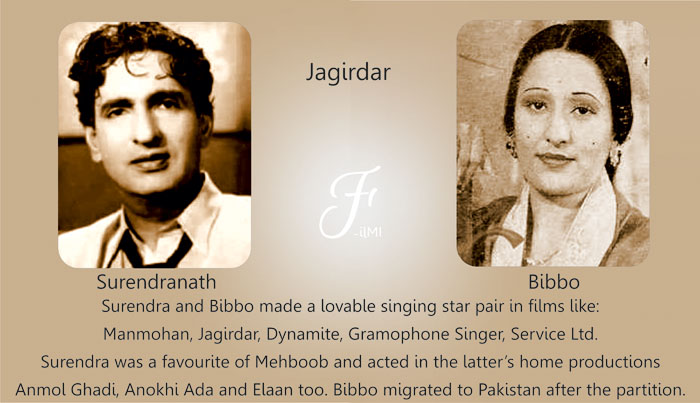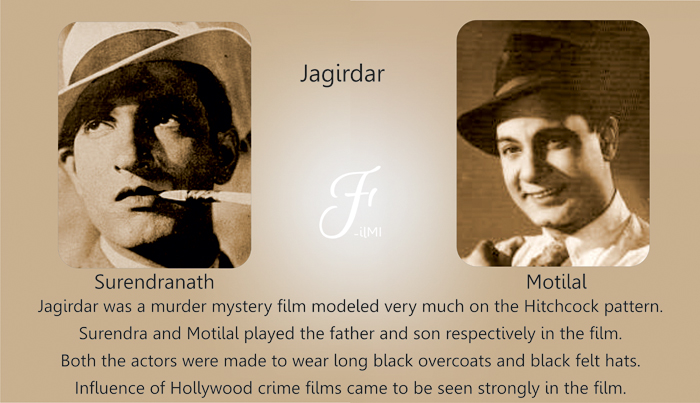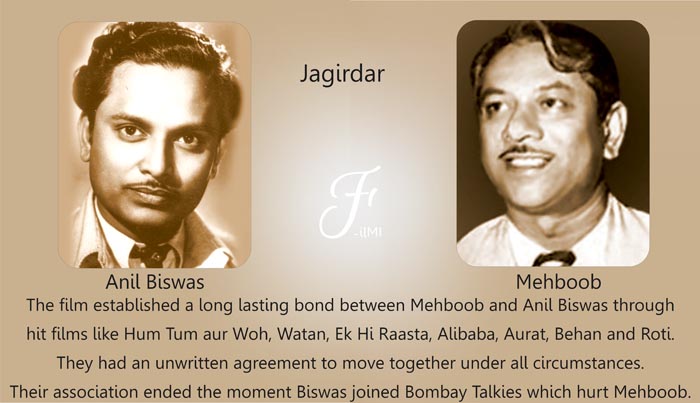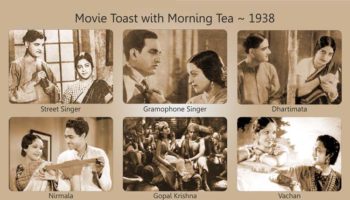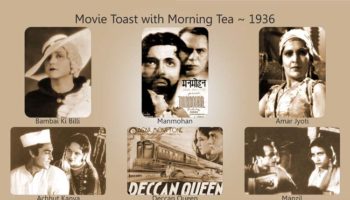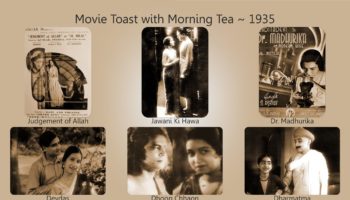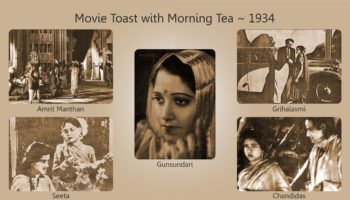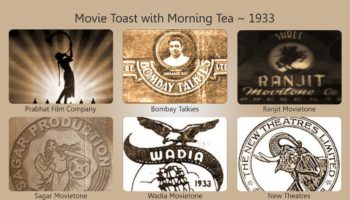Movie Toast with Morning Tea ~ 1937
Total number of films released during the year 1937 reduced to 102 from 154 in 1935 and 134 in 1936. Clearly, many of the conservative and older companies were not able to keep pace with their relatively newer contemporaries.
The top five films of the year were: “Duniya Na Maane” (Prabhat), “Jagirdar” (Sagar), “Mukti”, “President” and “Vidyapati” (New Theatres). All these films were significant and successful and were from the newer studios which had, by the mid 30s, established themselves well on the filmy firmament with their brand of films. Yet another film of historical significance was “Kisan Kanya” (Imperial).
Imperial
Ardeshir Irani’s Imperial Films released as many as eight films during the year. He added yet another feather to his cap by making the first indigenous ‘cine colour’ film “Kisan Kanya”. In 1933, V Shantaram made an attempt to make a colour film with Prabhat’s “Sairandhri”. He gave up half way as he was not happy with the techniques and the processing which was done in Germany. The film was released finally in black and white.
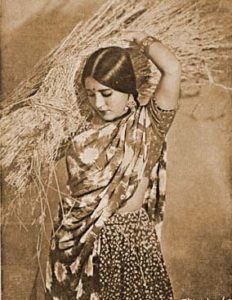 “Kisan Kanya” was a socially relevant film on the exploitation and plight of the poor farmers based on a story by the controversial genius Saadat Hasan Manto. It was also, arguably, the first film to highlight the plight of farmers. The film was directed by Moti Gidwani who later went on to direct Pancholi’s “Khazanchi” (1941) which brought a musical revolution in Indian Cinema and “Zamindar” (1942). “Kisan Kanya” is believed to be a moderate success.
“Kisan Kanya” was a socially relevant film on the exploitation and plight of the poor farmers based on a story by the controversial genius Saadat Hasan Manto. It was also, arguably, the first film to highlight the plight of farmers. The film was directed by Moti Gidwani who later went on to direct Pancholi’s “Khazanchi” (1941) which brought a musical revolution in Indian Cinema and “Zamindar” (1942). “Kisan Kanya” is believed to be a moderate success.
Prabhat
To keep pace with New Theatres and their socially relevant films and films drawn from Bengali literature, Shantram too shifted focus from mythological and period films to social issues. In his concern about the treatment meted out to women in Indian society, Shantaram first treated allegorically the oppressed condition of women in “Amar Jyoti” (1936) and found fuller expression in “Duniya Na Maane” and “Aadmi” (1939).
The great classic “Duniya Na Maane” was based on the Marathi novel “Na Patnaari Gosht” by Narayan Hari Apte. The film condemned the evils of dowry system (Shantaram handled the theme again in “Dahej” in 1950) and the deplorable and despicable custom of young girls married off to older men.
Shanta Apte played the role of a wronged young woman who is forced to marry an aging widower (played by Keshavrao Date) old enough to be her father. She protests and rebels against the marriage and outrages the orthodoxy with pronounced contempt and disgust. Her agonies and sufferings manifest in her confrontation with her ‘husband’ who is denied the conjugal rights and who is constantly in a mental struggle for the wrong done. Her hard hitting dialogues are a caustic comment on the conservative and hidebound values of the society. To all her scathing attack on his undoing, Keshavrao Date stands as a mute spectator caught in the web of guilt ridden dilemma and helplessness, finally redeeming his act by putting an end to himself and releasing her from the bondage of marriage.
For its time, the film was a bold and daring effort and at the risk of offending the reactionaries and traditionalists and disrespecting their sensitivities and sensibilities, Shantaram succeeded with his highly revolutionary film.
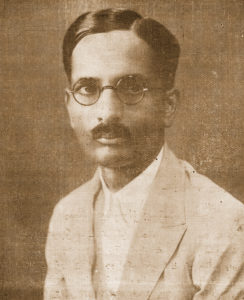 Keshavrao Bhole gave music for the film; the most popular song of the film was the ever lyrical and ever inspirational Mann saaf tera hai ke nahin poochh le jee se sung by Master Parshuram. Years later, S D Burman asked Sahir to pen Tadbeer se bigdi hui taqdeer banaale, yet another inspiring song on the same behar (meter) of the ‘Duniya na Maane’ ditty. The film also had the first English song ‘In the world’s broad field of battle’ (A Psalm of Life written by Henry Wadsworth Longfellow) sung by Shanta Apte.
Keshavrao Bhole gave music for the film; the most popular song of the film was the ever lyrical and ever inspirational Mann saaf tera hai ke nahin poochh le jee se sung by Master Parshuram. Years later, S D Burman asked Sahir to pen Tadbeer se bigdi hui taqdeer banaale, yet another inspiring song on the same behar (meter) of the ‘Duniya na Maane’ ditty. The film also had the first English song ‘In the world’s broad field of battle’ (A Psalm of Life written by Henry Wadsworth Longfellow) sung by Shanta Apte.
During the year, Prabhat released a period film “Wahan”. The film was directed by K Narayan Kale and starred Chandramohan, Shanta Apte, Leela Chitnis, Ulhas and Vasant Desai (who was assistant to the in house composers of Prabhat).
Prabhat’s “Sant Tukaram” (Marathi) received a special jury mention at the Venice Film Festival.
Sagar
Following the success of ‘”Judgement of Allah” (1935) and “Deccan Queen” and Manmohan” (1936), Mehboob Khan made yet another super hit film “Jagirdar” for Sagar. The film had an impressive ensemble of popular actors of the time: Motilal, Surendra, Maya Bannerji, Bibbo, Yakub, Bhudo Advani.
“Jagirdar” was a slick murder mystery film on the lines of Hitchcock’s thrillers. And though Surendra and Motilal were of the same age (both born in 1910 within a gap of a month), they played father and son respectively to the hilt without any awkwardness or discomfiture. With the success of the film, Mehboob consolidated his position as versatile director of great reckoning.
After associating as a ‘music arranger’ in “Manmohan”, Anil Biswas came to give music independently for “Jagirdar” and many other films of Sagar that followed. The film had popular songs like: Nadi kinaare baithke aao (Motilal and Maya Bannerji) and Pujari more mandir mein aao (Surendra and Bibbo). The film established the successful teaming of Surendra-Anil Biswas-Mehboob just like “Aradhana” (1969) inaugurated and established the team of Rajesh Khanna-Kishore Kumar-R D Burman-Shakti Samanta.
Sagar had a few more releases like “Captain Kirtikumar”, “Kokila”, “Kulvadhu”, “Mahageet” (an experimental film about retrieving voices of the dead from space) and “Sagar Ka Sher”. Anil Biswas gave music for “Kokila” and “Mahageet” besides, of course, “Jagirdar”.
New Theatres
The year clearly belonged to New Theatres with three major releases: “Mukti”, “President” and “Vidyapati” each film different from the other in theme, tone, texture, timber and treatment. The three films were directed by three distinguished in house directors: P C Barua, Nitin Bose and Debaki Bose respectively. All the three films were major hits at the box office.
Besides these, there was one more film “Anaath Ashram” based on the progressive theme of ‘widow remarriage’. This was probably the first film on the sensitive issue which was later repeated with great success by Kishore Sahu in “Sindoor” (1947), Shantaram’s “Subah Ka Taara” (1954) and B R Chopra in “Ek Hi Raasta” (1956) and in the post 80s in films like “Prem Rog”, “Deewana” and “Babul”.
Mukti ~ Barua
Unlike the films of Debaki Bose and Nitin Bose which were mostly based on legend, history and / or Bengali literature or set in socio-economic backdrop, Barua’s films were more contemporary and modern with the class divide element and delved deep into the complexities of human relations. As such his protagonists (more often the male actors) were quite often marked by ‘contradictions, flaws, humanity and weaknesses’. Death, of course, was a leitmotif providing solution to and salvation from all the self created miseries – as in “Devdas” (1935). “Manzil” (1936) or “Mukti”.
“Mukti” is one such classic film on adultery and complex relationship with all the aforesaid mawkish traits inherent in man. The film starred Barua himself as a disillusioned painter and Kanan Devi as the rich, adulteress wife.
The film had music by Pankaj Mullick who also played a cameo in the film. He sang the popular song Kaun desh hai jaana babu which is believed to be a loose translation of Rabindranath Tagore’s Diner sheshe ghumer deshe. Pankaj Mullick had gone to meet Tagore to seek permission to use his song for the Bengali version. On hearing the story, the poet suggested the title “Mukti”. Other popular songs of the film were Sanwariya mann bhaaya re and Kaisa ujda chaman khushi ka, Na jaane kya hai dil ka raag, all three rendered by Kanan Devi. The latter two were composed by R C Boral.
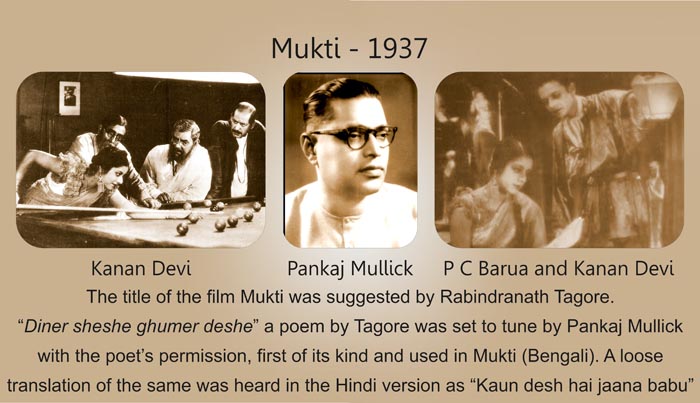
President ~ Nitin Bose
“President”, directed by Nitin Bose, was one of the earliest romantic triangles with K L Saigal, Kamlesh Kumari and Leela Desai forming the three angles of the triangle. As mentioned before, films of Nitin Bose were set in naturalistic and realistic socio-economic background and in “President”, a textile mill provides the backdrop of the film where the story unfolds.
Music was given jointly by R C Boral and Pankaj Mullick and the most popular song of the film was the iconic dream wish of everyone Ek bangala bane nyaara rendered by K L Saigal in his inimitable style.
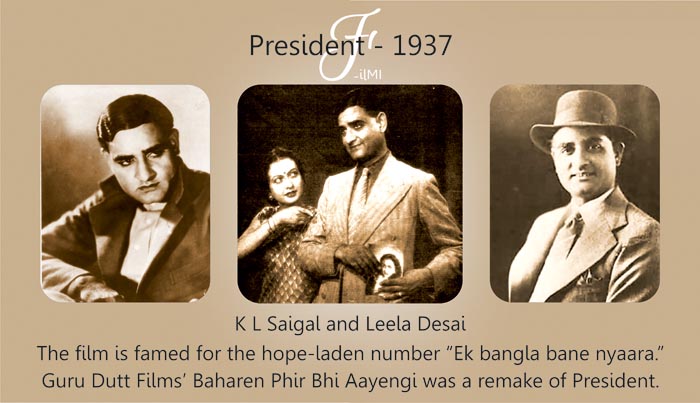
Guru Dutt’s “Baharen Phir Bhi Aayengi” was a remake of “President” with Dharmendra, Mala Sinha and Tanuja essaying the roles of Saigal, Krishna Kumari and Leela Desai respectively. Here the backdrop of a textile mill is replaced by a newspaper company.
Vidyapati ~ Debaki Bose
The third offering of the year from New Theatres was “Vidyapati” based on the life and lyrical works of the 14th century Vaishnava saint-poet Vidyapati. The film was directed by Debaki Bose who drew heavily from legend and history for his subjects. Pahari Sanyal played the role of Vidyapati and Prithviraj Kapoor, the King of Mithila and Chhaya Devi his queen. The film also had big names like Kanan Devi, K C Dey, K N Singh, Leela Desai.
Though drawn from history, the content and intent of the film was more like any film of Barua with complex human relationships (with the Queen of Mithila falling for the King’s poet-friend Vidyapati and his poetry), stark pessimism and, not the least, the inevitable death providing salvation (the King dies of shock and the Queen consumes poison).
Music was by R C Boral and some of the popular songs (now forgotten) from the film include: Dole hriday ki naiyya, Hamri nagariya mein aaye baso banwari, More angna mein aaye aali (by Kanan Devi), Panghat pe kanhaiya aata hai and Gokul se gaye giridhari (by K C Dey) and Darshan hue tihaare saajan and Ek din Radha ne bansuriya (by Pahari Sanyal).
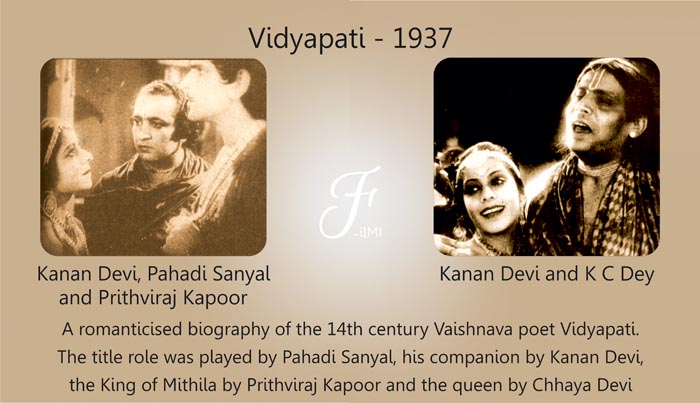
Bombay Talkies
Himanshu Rai’s Bombay Talkies was easily among the top five studios of the 30s. The studio established itself with “Achhut Kanya” in the earlier year. The studio had as many as four releases in 1937: “Izzat” and “Savitri” (both starring Ashok Kumar and Devika Rani) and “Jeevan Prabhat” and “Prem Kahani”.
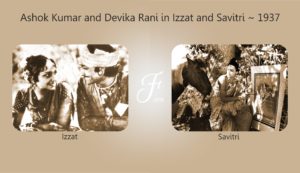
“Savitri” is probably the only mythological film in which Ashok Kumar acted. While “Izzat” focused on the struggle of a tribal community to safeguard their ‘dignity and honour’, “Prem Kahani” had a progressive social theme of why parents should not control the lives of their adult children and force them for arranged marriages. “Jeevan Prabhat” was an extension of “Achhut Kanya” with the class divide and conflict as its theme. For Devika Rani is was a reversal of her ‘untouchable’ role in “Achhut Kanya”; in this film she played a girl from an orthodox upper crust Brahmin family in love with a low caste potter.
All the films were directed by Franz Osten and music was by Saraswati Devi. However, none of these films could match the success of “Achhut Kanya”.
Companies and studios like Minerva Movietone, Prakash Pictures, Ranjit, Wadia had nothing significant to contribute artistically or cinematically. With the exception of Wadia, the others made action and stunt films which really were not their forte and with which they were not generally associated in the later years. Incidentally, Wadia’s film “Naujawan” directed by Aspi becomes the first ‘song less’ film’ at a time when music and dance had become essential ingredients of box office.
Notable Natter ~ 1937
Manoj Kumar (actor) and Laxmikant (of the composer duo Laxmikant-Pyarelal) were born in the year. And they were to parent the timeless classic “Ik pyar ka naghma hai” a full 35 years later.
The Indian Motion Pictures Producers’ Association (IMPPA) was founded in Bombay.
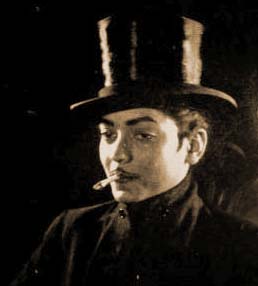 Leela Chitnis had yet to make her demure, girl next door presence in successful films of Bombay Talkies like “Kangan” (1939), “Bandhan” (1940) and Jhoola” (1941) opposite Ashok Kumar. Before these films, she played a ‘suave crook’ in Ram Daryani’s “Gentleman Daku” and was seen dressed in male outfits. She was publicized in the Times of India as the ‘First Graduate Society Lady from Maharashtra’. Probably, she would have continued to do such roles if she was not ‘domesticated’ by Bombay Talkies in their social films that followed.
Leela Chitnis had yet to make her demure, girl next door presence in successful films of Bombay Talkies like “Kangan” (1939), “Bandhan” (1940) and Jhoola” (1941) opposite Ashok Kumar. Before these films, she played a ‘suave crook’ in Ram Daryani’s “Gentleman Daku” and was seen dressed in male outfits. She was publicized in the Times of India as the ‘First Graduate Society Lady from Maharashtra’. Probably, she would have continued to do such roles if she was not ‘domesticated’ by Bombay Talkies in their social films that followed.
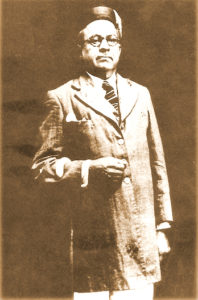 Dadasaheb Phalke directed his first and last sound film “Gangavataran” based on tales from the Puranas. He directed the film for Kolhapur Cinetone and he was 67 years when he wielded the megaphone. This was his ‘last desperate attempt’ but age, associated ailments and an altogether different atmosphere affected the performance of the film at the box office. The last film of Phalke became the first film to be screened at Bombay’s Royal Opera House.
Dadasaheb Phalke directed his first and last sound film “Gangavataran” based on tales from the Puranas. He directed the film for Kolhapur Cinetone and he was 67 years when he wielded the megaphone. This was his ‘last desperate attempt’ but age, associated ailments and an altogether different atmosphere affected the performance of the film at the box office. The last film of Phalke became the first film to be screened at Bombay’s Royal Opera House.
The era of films based on epics and mythology had virtually come to an end. And in the changed scenario of film making which focused on films on social issues and reforms with dialogues, music, dance, drama, action, thrills, Phalke felt himself out of sync with the trend and techniques and was almost forced to call it a day with “Gangavataran”. Clearly, Phalke and other earlier pioneers of Indian Cinema were getting relegated to the annals of history.
Looking back, one cannot help reiterating the fact that the latter day progress, the accomplishments, the technical and technological revolutions were all made possible by the initiatives taken by these forgotten pioneers and their successors in the thirties, however imperfectly!
Top Twelve Popular Songs of 1937
| Name of Film | Song | Singer/s |
| Duniya Na Maane | In the worl’s broadfield of battle | Shanta Apte |
| Duniya Na Maane | Mann saaf tera hai ke nahin | Master Parshuram |
| Jagirdar | Nadi kinaare baithke aao | Motilal ~ Maya Bannerji |
| Jagirdar | Pujari more mandir mein aao | Surendra ~ Bibbo |
| Mahageet | Prem ka pushp khila ghar mere | Surendra |
| Mukti | Kaun desh hai jaana babu | Pankaj Mullic |
| Mukti | Sanwariya mann bhaaya re | Kanan Devi |
| President | Ik bangala bane nyaara | K L Saigal |
| President | Ik raaje ka beta | K L Saigal |
| Vidyapati | Dole hriday ki naiyya | Kanan Devi |
| Vidyapati | Gokul se gaye Giridhari | K C Dey |
| Vidyapati | Panghat pe kanhaiya aat hai | K C Dey |

